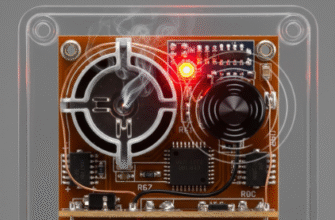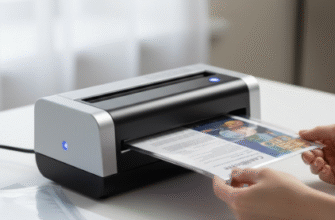Ever walked into your home and it felt just right? Not too hot, not too cold? If you have a smart thermostat, that pleasant feeling isn’t just luck; it’s the result of some clever technology learning exactly what you like. These devices aren’t just fancy timers; they actively adapt to your life, aiming for that perfect balance of comfort and energy efficiency. But how exactly does this little device on your wall become so attuned to your preferences? It boils down to a combination of sensors, your own actions, and some basic artificial intelligence principles working behind the scenes.
Think of your smart thermostat as a diligent student, eager to learn the rhythms of your household. Its education starts the moment you install it, but the real learning happens day by day, hour by hour. It’s constantly gathering data, looking for patterns, and making predictions about what temperature will make you most comfortable at any given time.
The Foundation: Initial Setup and Sensors
When you first set up a smart thermostat, you usually provide some basic information. This might include your location (crucial for accessing local weather data), perhaps some initial details about your home (like its size or type of heating system), and maybe even a very basic starting schedule. This gives the thermostat a starting point, a baseline from which to begin its learning journey.
But the real data collection comes from its built-in sensors. Most smart thermostats include:
- Temperature Sensors: Obviously essential. They constantly measure the ambient temperature in the room or area where the thermostat is located.
- Humidity Sensors: Humidity plays a big role in how temperature feels. 70 degrees feels very different in dry air versus humid air. Tracking humidity helps the thermostat fine-tune comfort levels more accurately.
- Occupancy/Motion Sensors: Many models use infrared or other technologies to detect if someone is present in the room or moving around the house. This is key for learning when you’re typically home or away.
These sensors are the eyes and ears of the thermostat, providing a continuous stream of raw data about the immediate environment and activity within your home.
Your Adjustments: The Most Important Teacher
Here’s the crucial part: you are the primary teacher. Every time you manually adjust the temperature on the thermostat itself, through its app, or even via voice commands, you’re providing valuable feedback. You’re essentially telling the thermostat, “Okay, whatever you thought was right for this moment, it wasn’t. This temperature is what I actually prefer right now.”
Imagine you consistently turn the heat up every morning around 7 AM. The thermostat logs this. Perhaps you turn the air conditioning down every evening when you get home from work around 6 PM. Logged. Maybe you lower the temperature significantly when you leave for work on weekdays but not on weekends. Logged, logged, logged. Each adjustment is a data point, a specific instruction tagged with a time, a day, and the environmental conditions recorded by its sensors.
Verified Information: Smart thermostats primarily learn through observing user interactions. Manual temperature adjustments serve as direct feedback, forming the core data set for preference learning. Consistent patterns in these adjustments allow the device to build a predictive schedule.
Finding the Patterns: Where the AI Comes In
Collecting data is one thing; making sense of it is where the “smart” part truly lies. The thermostat uses algorithms – sets of rules and calculations – to sift through all the data it has collected (your manual adjustments, sensor readings, maybe even occupancy information) and identify recurring patterns.
At its simplest, this might look like basic scheduling logic:
- “Okay, on weekdays, the user consistently turns the heat up to 68 degrees between 7:00 AM and 7:30 AM.”
- “They seem to lower the temperature to 65 degrees around 9:00 AM on weekdays, likely when they leave.”
- “Occupancy sensors show the house is usually empty between 9 AM and 5 PM on weekdays.”
- “Evenings, especially after 6 PM, tend to see the temperature set to 70 degrees.”
- “Weekends look different; the morning warm-up happens later, around 8:30 AM, and the temperature stays more consistent throughout the day.”
Moving Beyond Simple Schedules
More sophisticated thermostats employ basic machine learning techniques. Don’t let the term intimidate you; think of it as advanced pattern recognition. Instead of just looking for simple time-and-temperature correlations, these algorithms can start to factor in other variables.
For example, the thermostat might learn:
- Weather Influence: “On sunny winter days, even if it’s cold outside, the house warms up naturally due to sunlight (solar gain). I might not need to turn the heat on quite as early or as high compared to a cloudy day with the same outside temperature.”
- Humidity’s Role: “When humidity is high, the user tends to prefer a slightly lower AC setting to feel comfortable.”
- Occupancy Optimization: “Even though the user sometimes comes home early on Fridays, they always turn the temperature down if they then leave again shortly after. I should wait for confirmed, sustained presence before adjusting to the ‘home’ setting, or perhaps use an ‘Away’ mode more readily.”
This is a form of supervised learning in AI terms. Your manual adjustments act as the ‘correct answers’ or ‘labels’ for the data points (the time, sensor readings, etc.). The algorithm tries to build a model that accurately predicts the ‘correct answer’ (your preferred temperature) given a similar set of inputs in the future.
Occupancy Sensing: Learning When You’re There (and When You’re Not)
Motion or presence sensors add another layer to the learning. They help the thermostat understand your actual presence patterns, not just your scheduled ones. If the thermostat detects no motion for an extended period during a time you’re normally home, it might infer you’ve unexpectedly stepped out and automatically switch to a more energy-saving ‘Away’ temperature. Conversely, if it detects motion when you’re usually away, it might prompt you or automatically adjust to a comfortable ‘Home’ setting sooner than scheduled.
Over time, it correlates occupancy data with your manual settings and schedule adjustments. It learns that when the house is empty, you typically prefer (or at least tolerate) a wider temperature band to save energy. This allows it to build smarter ‘Home’ and ‘Away’ modes that truly reflect your household’s activity.
Important Information: The effectiveness of occupancy-based learning depends heavily on sensor placement and the layout of your home. A thermostat in a low-traffic hallway might not accurately detect presence in main living areas. Consider this when relying on auto-away features.
Adapting and Refining Over Time
Learning isn’t a one-time event. Your smart thermostat is constantly refining its understanding. It adapts to:
- Seasonal Changes: Your heating preferences in deep winter are likely different from your cooling preferences in peak summer. The thermostat learns these seasonal shifts.
- Schedule Variations: If your work schedule changes, or you start working from home, your continued adjustments will teach the thermostat the new routine.
- Subtle Preference Drifts: Maybe you gradually start preferring the house a degree warmer in the evenings. Consistent small adjustments will slowly shift the learned schedule.
It’s also designed to handle anomalies. A single day with an unusual schedule or a house full of guests won’t usually cause it to drastically overhaul its learned patterns. It looks for consistency over time.
External Factors
Some advanced models also pull in external data:
- Weather Forecasts: Knowing a heatwave is coming allows the thermostat to pre-cool the house more efficiently before peak temperatures hit.
- Utility Rates: In areas with time-of-use electricity pricing, some thermostats can learn to pre-heat or pre-cool during cheaper off-peak hours, reducing energy costs while maintaining comfort during expensive peak times.
This integration allows for even smarter predictions and optimizations, going beyond just your direct interactions.
The Feedback Loop Continues
Even after weeks or months, your interaction remains key. If the thermostat sets a temperature you don’t like, adjusting it reinforces the learning process. You’re always providing feedback. Most smart thermostat apps also allow you to view the learned schedule and make manual tweaks to it, giving you ultimate control while still benefiting from the automated learning.
In essence, a smart thermostat learns your preferences through a continuous cycle:
Sense -> Predict -> Act -> Get Feedback -> Refine Prediction -> Repeat
It senses the environment and your presence. It uses its learned patterns (based on your past feedback) to predict the optimal temperature. It acts by controlling your HVAC system. It gets feedback if you manually adjust the temperature. It refines its internal predictive model based on that feedback. And the cycle continues, getting progressively better at anticipating your needs.
So, the next time you appreciate the effortless comfort of your home, remember the ongoing conversation happening between you, your thermostat’s sensors, and the clever algorithms working tirelessly to learn exactly what makes your environment feel just right. It’s not magic, but a practical application of AI principles designed around your unique comfort.







